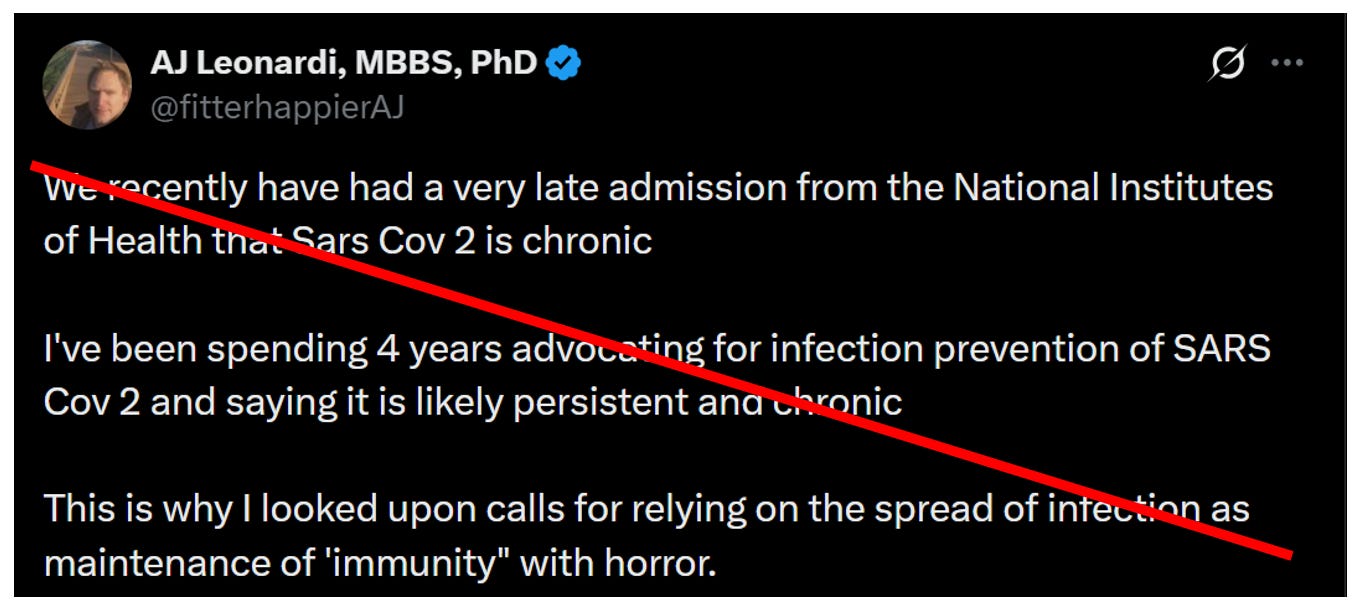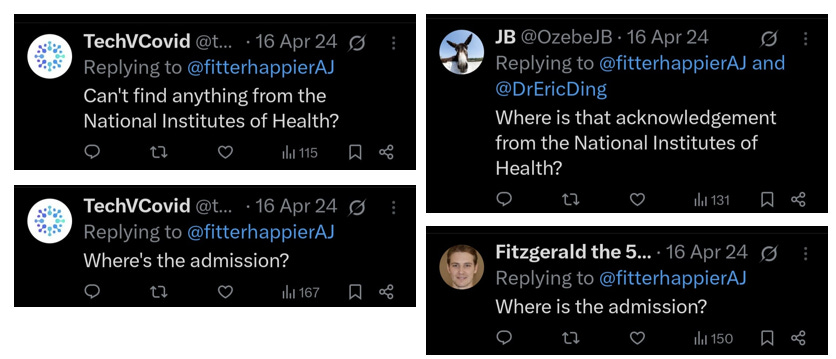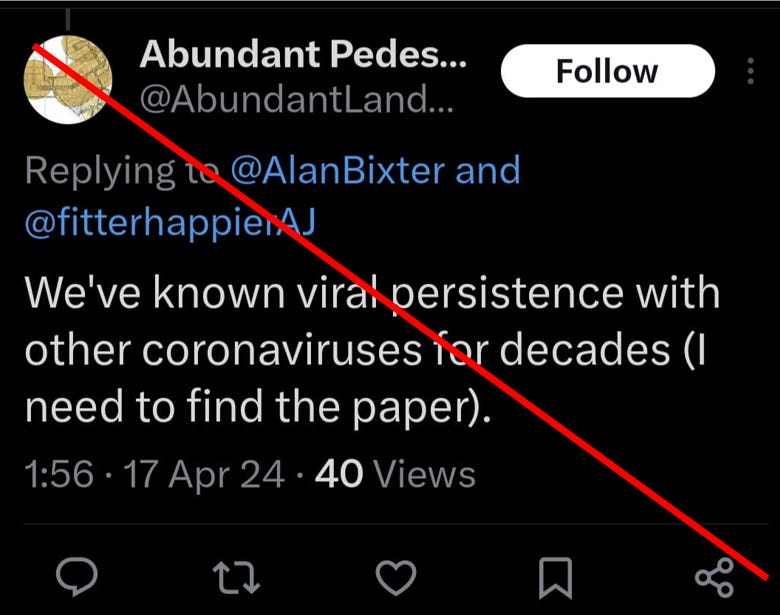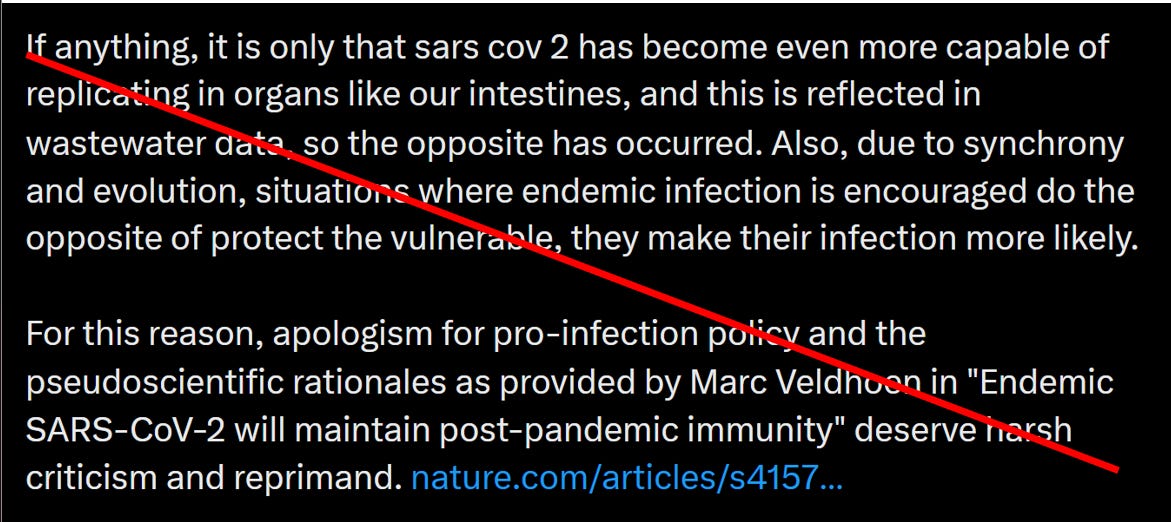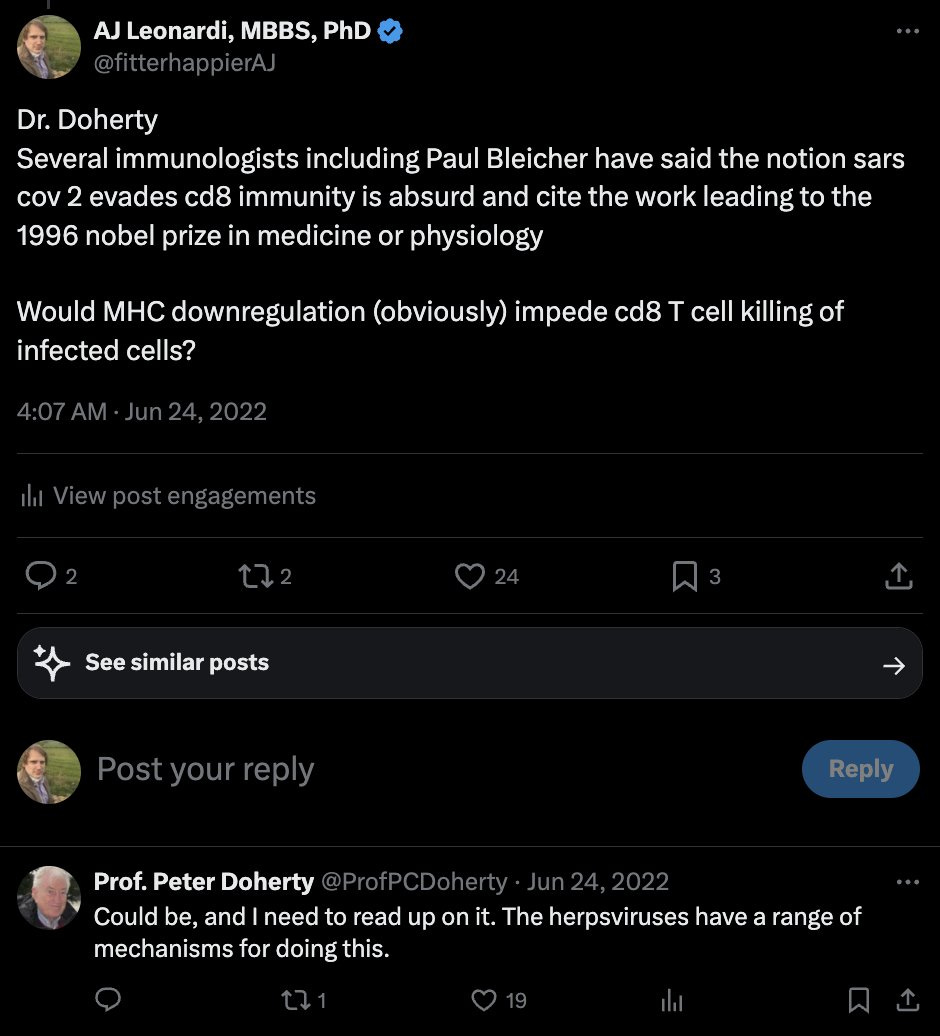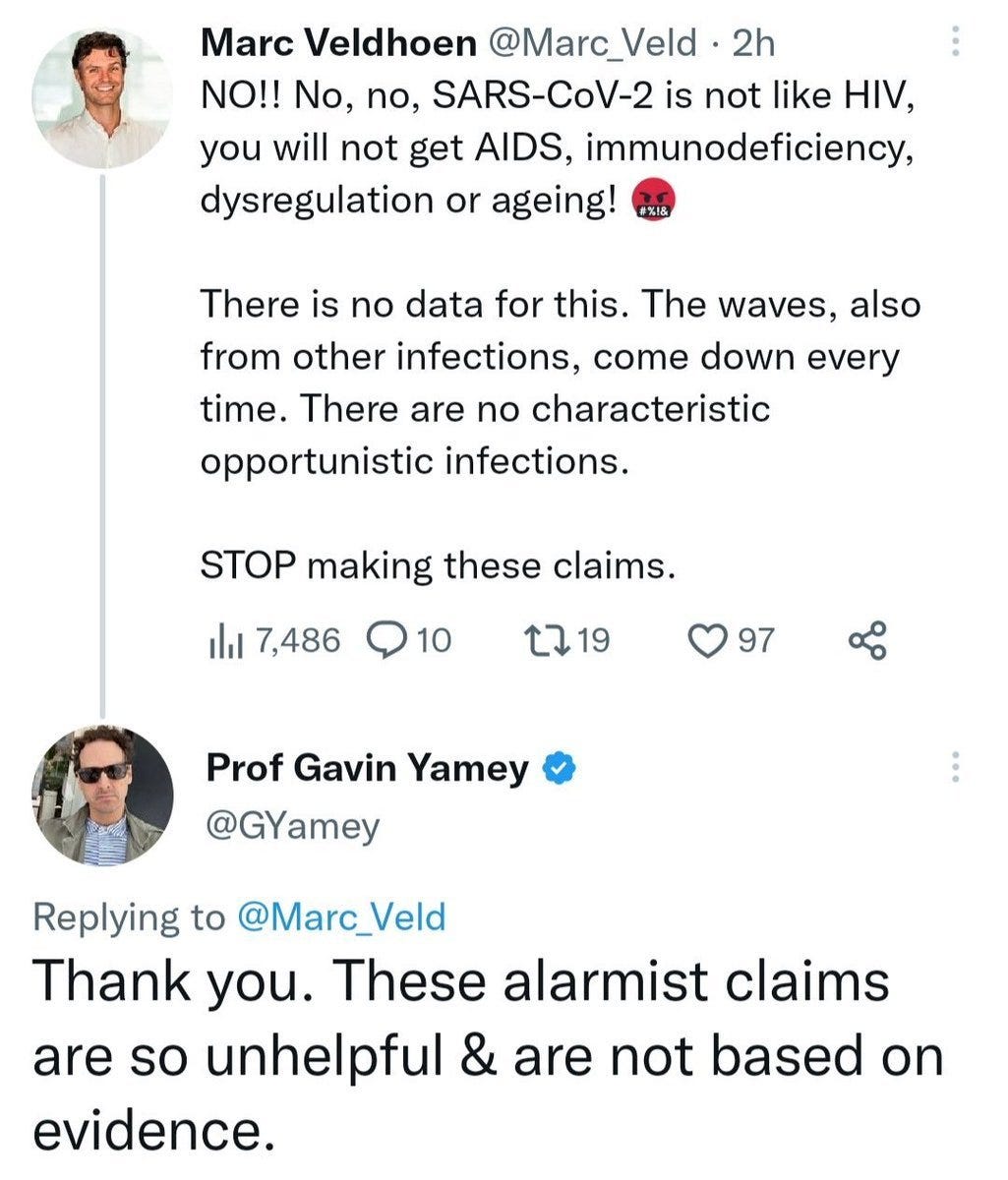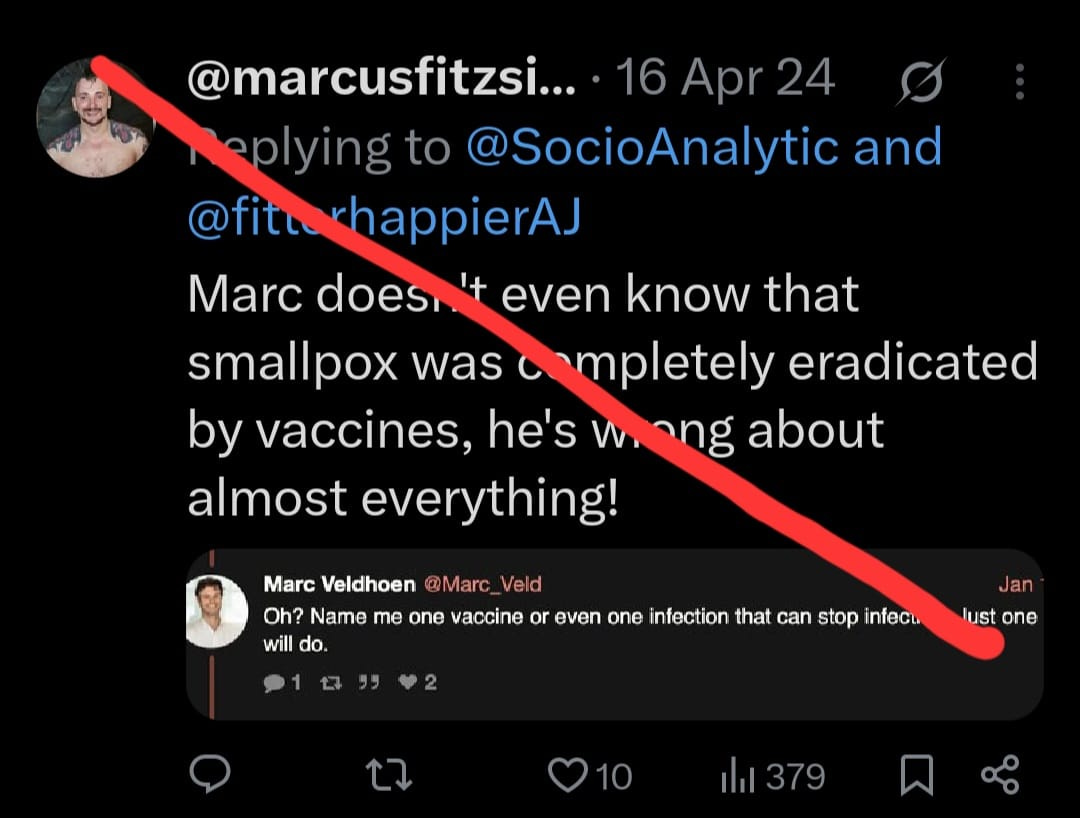The lies keep on coming from the infection disinformation high priest.
and why there is no vaccine stopping transmission
The self-proclaimed COVID-19 expert who has been time and time again shown to be wrong and have little understanding of immunology. Anthony J. Leonardi's assertions regarding SARS-CoV-2's chronicity and immune damage, dysregulation, exhaustion, super-antigens and evasion contain several inaccuracies and misrepresentations of current and past scientific understanding. Here a recent post and the reactions it received will be critically examined using expert immunology knowledge and peer-reviewed literature as well as official health sources.
Lets start with a very easy one. One that should have raised red flags immediately and is straightforward to fact-check:
1. Claim: NIH Admitted SARS-CoV-2 Is a Chronic Virus
Assessment: Leonardi suggests that the National Institutes of Health (NIH) has acknowledged SARS-CoV-2 as a chronic virus. Chronic does not mean it can cause chronic symptoms, every infection can do that, but that the virus is not cleared. This is something that can happen with retroviruses such as HIV, which integrates in the genome, and herpes-(like) viruses that have the ability to infect but hold the progression to make new viruses until a time when immunity may be weaker. Varicella zoster virus (VZV) is such a virus, causing chickenpox at a young age, but can re-awaken at a later time to cause shingles. SARS-CoV-2 is a coronavirus, which is not a retrovirus or a herpes-(like) virus.
Evidence: The NIH has recognized that some individuals experience prolonged symptoms post-infection, a condition often referred to as "Long COVID" or post-acute sequelae of SARS-CoV-2 infection (PASC). However, this acknowledgment pertains to the persistence of symptoms, not the virus itself. For instance, the NIH's RECOVER Initiative notes an increase in myalgic encephalomyelitis/chronic fatigue syndrome (ME/CFS) cases following COVID-19, indicating prolonged health effects but not chronic viral infection. The NIH or other government branch has not made a claim about SARS-CoV-2 to be a virus with general persistent infection.
Several did indeed question this:
Conclusion: Equating persistent symptoms with chronic infection misrepresents the NIH's position. Claiming the NIH has said SARS-CoV-2 is a virus that chronically infects us is a lie.
2. Claim: SARS-CoV-2 Is Persistently Infecting a Significant Portion of the Population
Assessment: Leonardi implies that SARS-CoV-2 establishes persistent infections in a substantial segment of individuals.
Evidence: It chronic infection possible? Yes, like with any infection, if your immune response is not sufficiently strong, immunodeficient, chronic infection is possible with, depending on the exact reason for the deficiency, most pathogens. This we have indeed seen with SARS-CoV-2 as well, and has most likely resulted in at least the variants Alpha and Omicron.
Persistent SARS-CoV-2 infections have been documented, predominantly in immunocompromised patients. These cases are exceptions rather than the norm. In the general population, the virus is typically cleared within weeks, and persistent infection is not common.
We know that from the other human corona viruses, such as OC43, NL63, 229E and HKU.1 …. but happy to see that literature!
Conclusion: The assertion that SARS-CoV-2 persistently infects a large portion of the population lacks supporting evidence.
3. Claim: I Advocated Against Vaccination, Favoring Natural Infection
Assessment: Leonardi criticizes me for purportedly suggesting that natural infection would suffice for immunity, rendering vaccinations unnecessary.
Evidence: In the Nature Reviews Immunology (not Nature Immunology, even that Leonardi gets wrong) commentary titled "Endemic SARS-CoV-2 will maintain post-pandemic immunity," Pedro Simas and myself discuss the role of both infection and vaccination in establishing immunity. We do not argue against vaccination but rather explore how endemic circulation might contribute to long-term immunity alongside vaccination efforts.
We specifically argue against letting the virus spread: “Relying on natural infection alone will expose the vulnerable to unacceptable risks and result in differing levels of pathology in a proportion of the population.”
Conclusion: Leonardi's portrayal of my stance is a misrepresentation of the original commentary. This is his known MO, misrepresentation of people, knowledge, facts, data and papers.
4. Claim: SARS-CoV-2 Has Evolved to Infect the Gut More Prolifically
Assessment: Leonardi suggests that the virus has become more adept at infecting the gastrointestinal (GI) tract.
Evidence: SARS-CoV-2 can infect the GI tract due to the presence of ACE2 receptors. However, there is no conclusive evidence indicating that newer variants have specifically evolved to target the gut more effectively. The presence of viral RNA in wastewater reflects shedding from infected individuals, as it does with other respiratory infections such as the influenza viruses, but does not necessarily indicate increased GI infectivity.
Conclusion: While GI symptoms can be associated with respiratory infections such as SARS-CoV-2, the claim of evolved increased gut infectivity lacks, again, evidence.
5. Claim: SARS-CoV-2 Causes Significant T Cell Dysregulation and Immune Aging
Assessment: Leonardi asserts that the virus leads to substantial T cell dysfunction and accelerates immune aging.
Evidence: Studies have shown that infections, including SARS-CoV-2, can impact immune cell, including T cell, responses, particularly in severe cases. However, in most individuals, especially those with mild or asymptomatic infections, the immune system, including T cells, responds effectively and recovers post-infection. The concept of widespread immune aging due to SARS-CoV-2 is not supported by evidence. This I discussed in more detail here: The Immune System Post-SARS-CoV-2 – Resilient, Adaptive, and Fully Functional, past and SARS-CoV-2-specific data show our immune response is as it should, recovers as it should, does not suffer from exhaustion, dysfunction, depletion, etc. This becomes painfully clear when we are re-infected with SARS-CoV-2 (the SC2-specific response) or look at vaccination of influenza responses (other, non-SC2 responses).
Conclusion: While T cell alterations can occur and are largely the physiological response to an infection. These can differ per person, in some even contribute to immunpathology, like in all infections. The claim of universal immune aging post-COVID-19 is unsubstantiated and I have addressed this previously and a recent publication shows no ageing after infection.
6. Claim: Downregulation of MHC I by SARS-CoV-2 Is a Major Concern
Assessment: Leonardi emphasizes the virus's ability to downregulate MHC I molecules, suggesting significant immune evasion.
Evidence: Research indicates that SARS-CoV-2 accessory proteins, such as ORF7a and ORF3a, can downregulate MHC I expression. However, many pathogens, especially viruses, will do this, succeed to some extend, and the fail. The same holds true for SARS-CoV-2. The immune system employs multiple mechanisms to detect and eliminate infected cells, and MHC I downregulation is a common viral strategy not unique to SARS-CoV-2.
Conclusion: While MHC I modulation is noteworthy for infections, including SARS-CoV-2, it does not singularly compromise immune defense against the virus.
7. Claim: A Significant Proportion of Individuals Have Chronic SARS-CoV-2 Infections
Assessment: Leonardi claims that at least 20-25% of individuals exhibit evidence of chronic infection.
Evidence: Long COVID affects a subset of individuals, with estimates varying but generally lower than the percentages stated. Persistent symptoms do not equate to chronic infection, and the majority of individuals recover without long-term viral persistence.
Conclusion: The assertion that a quarter of individuals have chronic infections is not supported by data (yeah, again).
8. Claim: Critics Dismiss Technical Language as 'Technobabble'
Assessment: Leonardi want to be a victim and suggests that his use of technical terminology is unfairly criticized.
Evidence: Effective scientific communication requires clarity and accuracy. Using complex terms without proper context can hinder understanding. Critiques may stem from the need for clearer explanations rather than dismissal of the content. But, this is not really the issue, the complaint is so he can hide behind terminology and has an excuse for when he is called out yet again, for being very, very wrong.
Conclusion: Clear communication is essential; feedback on language use should be viewed as an excuse for Leonardi to getting is wrong, for not understanding the science and for cheating his followers.
Before I forget, he also comes with “evidence” for his claims. 4 screenshots.
Well, do data there.
Again no data here, but a correct statement that those suffering from LongCovid are a subset of the whole population. Hence, you cannot extrapolate what happens in these patients to everyone.
It continues with his own wrong understanding of immunology. This is a constant in all his posts, discussions and communications.
The last one concerns me, does it “proof” I want everyone infected? No, it is to dispel the awful and frankly idiotic claim that SARS-CoV-2 causes AIDS. It is a horribly claim for which there is no data at all, but that causes many people great mental anguish.
It there anything else? Well, going through the screenshots provides, not much but the usual suspects making the usual, and wrong claims and statements. It is truly bizarre to see people without any knowledge of the subject giving very confident and very wrong answers. However, they will not learn. It is a religion and they believe.
Some may genuinely want to ask questions. Unfortunately, the cult members are not the ones that can answer any of these questions.
Q. Why has there been no vaccine that can prevent transmission?
A. Such a vaccine does not exist.
Explanation: Our only pathogen-specific protection is provided by neutralising antibodies. Antibodies, including neutralising ones, are induced by vaccination, just like after infection. Their levels can be very high. But, they cannot stay high, they need to make room for new antibodies against new infections. The amount of protein in the blood would be too high for its function to flow and deliver oxygen. Hence, antibody levels drop over time. This leaves us more susceptible to infection, a trade off we need to make. But, the cells making these antibodies are stored, and instead of weeks to make these upon a primary encounter, are made within days, and much higher quality.
No matter infection or vaccination, the aim of your immune system to to prevent severe disease. It does that, and vaccination is the best way to acquire this pathogen-specific ability.
Now some may claim that vaccines can do this, such as against measles. This is incorrect and based on a misunderstanding by comparing vaccines and not the viruses (explained here). The infection with measles can happen after vaccination, just like with SARS-CoV-2, but: the virus is very slow to start multiplying and causing symptoms. You clear it before it can.
And yes, this holds true for Smallpox virus as well. After vaccination, it can, and does, infect.
So how was smallpox virus eradicated? By vaccination, many many vaccinations, frequently, and during any new infection, ring vaccination and containment measures. It was eradicated by vaccines and very, very hard work over 50 years. And yes, sometimes with brute force.
“Before 1967, the smallpox eradication strategy relied on mass vaccination. However, this strategy was ineffective in densely populated regions where containment measures proved more effective.“ “Prevention activities aimed to stop transmission by finding and treating anyone who had been in close contact with infected people, thereby preventing transmission to others.“
Yeah, vaccines do not stop transmission, but for the initial months after vaccination, whereafter they reduce the risk.
If you do not know the facts, you are prone to make stupid claims.



